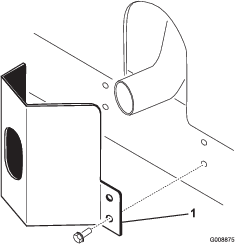| Maintenance Service Interval | Maintenance Procedure |
|---|---|
| Before each use or daily |
|
Introduction
This machine is a ride-on, reel-blade lawn mower intended to be used by professional operators in commercial applications. It is designed primarily for cutting grass on well-maintained lawns in parks, golf courses, sports fields, and on commercial grounds. It is not designed for cutting brush, mowing grass and other growth alongside highways, or for agricultural uses.
Important: To maximize the safety, performance, and proper operation of this machine, carefully read and fully understand the contents of this Operator’s Manual. Failing to follow these operating instructions or to receive proper training may result in injury. For more information on safe operating practices, including safety tips and training materials, go to www.Toro.com.
You may contact Toro directly at www.Toro.com for product safety and operation training materials, accessory information, help finding a dealer, or to register your product.
Whenever you need service, genuine Toro parts, or additional information, contact an Authorized Service Dealer or Toro Customer Service and have the model and serial numbers of your product ready. Figure 1 identifies the location of the model and serial numbers on the product. Write the numbers in the space provided.
Important: With your mobile device, you can scan the QR code (if equipped) on the serial number decal to access warranty, parts, and other product information.
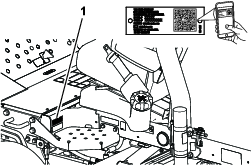
This manual identifies potential hazards and has safety messages identified by the safety-alert symbol (Figure 2), which signals a hazard that may cause serious injury or death if you do not follow the recommended precautions.

This manual uses 2 words to highlight information. Important calls attention to special mechanical information and Note emphasizes general information worthy of special attention.
This product complies with all relevant European directives. For details, please see the separate product specific Declaration of Conformity (DOC) sheet.
It is a violation of California Public Resource Code Section 4442 or 4443 to use or operate the engine on any forest-covered, brush-covered, or grass-covered land unless the engine is equipped with a spark arrester, as defined in Section 4442, maintained in effective working order or the engine is constructed, equipped, and maintained for the prevention of fire.
The enclosed engine owner’s manual is supplied for information regarding the US Environmental Protection Agency (EPA) and the California Emission Control Regulation of emission systems, maintenance, and warranty. Replacements may be ordered through the engine manufacturer.
Warning
CALIFORNIA
Proposition 65 Warning
Diesel engine exhaust and some of its constituents are known to the State of California to cause cancer, birth defects, and other reproductive harm.
Battery posts, terminals, and related accessories contain lead and lead compounds, chemicals known to the State of California to cause cancer and reproductive harm. Wash hands after handling.
Use of this product may cause exposure to chemicals known to the State of California to cause cancer, birth defects, or other reproductive harm.
Safety
This machine has been designed in accordance with EN ISO 5395:2013 and ANSI B71.4-2017.
General Safety
This product is capable of amputating hands and feet and of throwing objects. Always follow all safety instructions to avoid serious personal injury.
Using this product for purposes other than its intended use could prove dangerous to you and bystanders.
-
Read and understand the contents of this Operator’s Manual before starting the engine.
-
Do not put your hands or feet near moving components of the machine.
-
Do not operate the machine without all guards and other safety protective devices in place and working on the machine.
-
Use your full attention while operating the machine. Do not engage in any activity that causes distraction; otherwise, injury or property damage may occur.
-
Keep clear of any discharge opening. Keep bystanders and pets a safe distance away from the machine.
-
Keep children out of the operating area. Never allow children to operate the machine.
-
Stop the machine and shut off the engine before servicing, fueling, or unclogging the machine.
Improperly using or maintaining this machine can result in injury.
To reduce the potential for injury, comply with these safety instructions
and always pay attention to the safety-alert symbol  , which means Caution, Warning,
or Danger—personal safety instruction. Failure to comply with
these instructions may result in personal injury or death.
, which means Caution, Warning,
or Danger—personal safety instruction. Failure to comply with
these instructions may result in personal injury or death.
You can find additional safety information where needed throughout this Operator’s Manual.
Safety and Instructional Decals
 |
Safety decals and instructions are easily visible to the operator and are located near any area of potential danger. Replace any decal that is damaged or missing. |





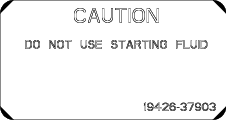
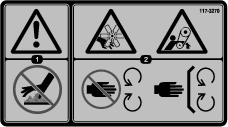




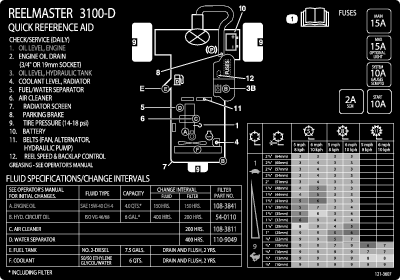
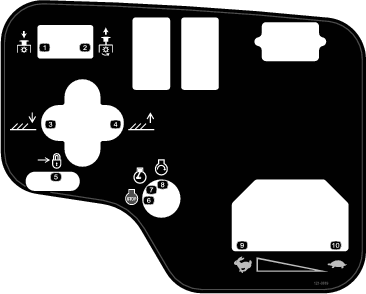
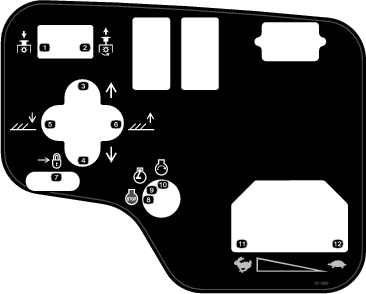

Setup
Note: Determine the left and right sides of the machine from the normal operating position.
Installing the Wheels
Parts needed for this procedure:
| Front wheel assemblies | 2 |
| Rear wheel assembly | 1 |
-
Mount a wheel assembly onto each wheel hub (valve stem outward).
Important: The rear tire has a narrower rim than the front tires.
-
Install lug nuts and torque to 61 to 88 N∙m (45 to 65 ft-lb).
Installing the Steering Wheel
Parts needed for this procedure:
| Steering wheel | 1 |
| Steering-wheel cap | 1 |
| Large washer | 1 |
| Jam nut | 1 |
| Screw | 1 |
-
Slide the steering wheel onto the steering shaft (Figure 3).
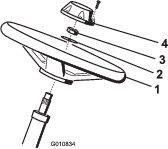
-
Slide the washer onto the steering shaft (Figure 3).
-
Secure the steering wheel to the shaft with a jam nut and tighten it to 27 to 35 N∙m (20 to 26 ft-lb) (Figure 3).
-
Install the cap to the steering wheel and secure it with a screw (Figure 3).
Activating, Charging, and Connecting the Battery
Parts needed for this procedure:
| Electrolyte | A/R |
Warning
Battery posts, terminals, and related accessories contain lead and lead compounds, chemicals known to the State of California to cause cancer and reproductive harm. Wash hands after handling.
Note: If the battery is not filled with electrolyte or activated, bulk electrolyte with 1.260 specific gravity must be purchased from a local battery supply outlet and added to the battery.
Danger
Battery electrolyte contains sulfuric acid which is a deadly poison and causes severe burns.
-
Do not drink electrolyte and avoid contact with skin, eyes, or clothing. Wear safety glasses to shield your eyes and rubber gloves to protect your hands.
-
Fill the battery where clean water is always available for flushing the skin.
-
Purchase bulk electrolyte with 1.260 specific gravity from a local battery supply outlet.
-
Open the hood.
-
Remove the battery cover (Figure 4).
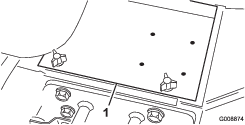
-
Remove the filler caps from the battery and slowly fill each cell until electrolyte is just above the plates.
-
Install the filler caps and connect a 3 to 4 A battery charger to the battery posts. Charge the battery at a rate of 3 to 4 A for 4 to 8 hours.
Warning
Charging the battery produces gasses that can explode.
-
Keep sparks and flames away from battery.
-
Never smoke near the battery.
-
-
When the battery is charged, disconnect the charger from the electrical outlet and battery posts.
-
Remove the filler caps. Slowly add electrolyte to each cell until the level is up to the fill ring. Install the filler caps.
Important: Do not overfill the battery. Electrolyte will overflow onto other parts of the machine and severe corrosion and deterioration will result.
-
Install the positive cable (red) to the positive (+) terminal and the negative cable (black) to the negative (–) terminal of the battery and secure them with bolts and nuts (Figure 5). Make sure that the positive (+) terminal is all of the way onto the post and the cable is positioned snug to the battery. The cable must not contact the battery cover.
Warning
Incorrect battery cable routing could damage the tractor and cables causing sparks. Sparks can cause the battery gasses to explode, resulting in personal injury.
-
Always disconnect the negative (black) battery cable before disconnecting the positive (red) cable.
-
Always connect the positive (red) battery cable before connecting the negative (black) cable.
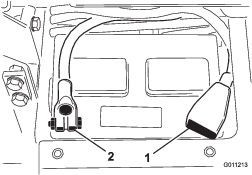
Important: If the battery is ever removed, make sure that the battery clamp bolts are installed with the bolt heads positioned on the bottom side and the nuts on the top side. If the clamp bolts are reversed, they may interfere with the hydraulic tubes when shifting the cutting units.
-
-
Coat both battery connections with Grafo 112X (skin over) grease, Toro Part No. 505-47, petroleum jelly, or light grease to prevent corrosion.
-
Slide the rubber boot over the positive terminal to prevent a possible short from occurring.
-
Install the battery cover.
Checking the Angle Indicator
Parts needed for this procedure:
| Inclinometer | 1 |
Danger
To reduce risk of injury or death due to rollover, do not operate the machine on side hills steeper than 25º.
-
Park the machine on a flat, level surface.
-
Verify that the machine is level by placing a hand held inclinometer (supplied with the machine) on the frame cross rail, by the fuel tank (Figure 6). The inclinometer should read zero degrees when viewed from the operator’s position.
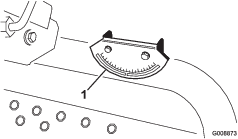
-
If the inclinometer does not read zero degrees, move the machine to a location where a zero degree reading is obtained. The angle indicator, mounted on the machine, should now read zero degrees as well.
-
If the angle indicator does not read zero degrees, loosen the 2 screws and nuts securing the angle indicator to the mounting bracket, adjust the indicator to obtain a zero degree reading, and tighten the bolts.
Installing the CE Decal
Parts needed for this procedure:
| Warning decal (121-3598) | 1 |
If this machine will be used for CE, affix the CE decal over the corresponding non-CE decal.
Installing the Hood Latch (CE Only)
Parts needed for this procedure:
| Lock bracket | 1 |
| Rivet | 2 |
| Washer | 1 |
| Screw (1/4 x 2 inches) | 1 |
| Locknut (1/4 inch) | 1 |
-
Unhook the hood latch from the hood-latch bracket.
-
Remove the rivets (2) securing the hood-latch bracket to the hood (Figure 7). Remove the hood-latch bracket from the hood.
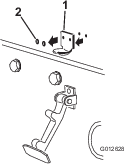
-
While aligning the mounting holes, position the CE lock bracket and the hood-latch bracket onto the hood. The lock bracket must be against the hood (Figure 8). Do not remove the bolt and nut assembly from the lock bracket arm.
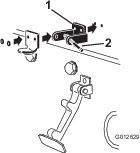
-
Align the washers with the holes on the inside of the hood.
-
Rivet the brackets and the washers to the hood (Figure 8).
-
Hook the latch onto the hood-latch bracket (Figure 9).
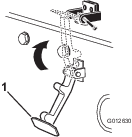
-
Screw the bolt into the other arm of hood-lock bracket to lock the latch in position (Figure 10).
Note: Tighten the bolt securely but do not tighten the nut.
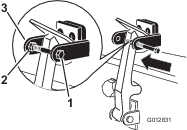
Installing the Exhaust Guard (CE Only)
Installing the Roll Bar
Parts needed for this procedure:
| Roll-bar assembly | 1 |
| Flange-head bolts | 4 |
| Locknuts | 4 |
| Hose clamp | 1 |
Important: Never weld or modify a rollover protection system (ROPS). Replace a damaged ROPS; do not repair or revise it.
-
Lower the roll bar onto the traction unit mounting brackets, aligning the mounting holes. Ensure that the vent tube on the roll bar is on the left side of the machine (Figure 12).
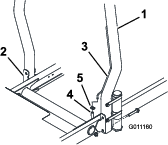
-
Secure each side of the roll bar to the mounting brackets with 2 flange head bolts and locknuts (Figure 12). Torque the fasteners to 81 N∙m (60 ft-lb).
-
Secure the fuel line vent hose to the vent tube on the roll bar with the hose clamp.
Caution
Starting the engine with the fuel line vent hose disconnected from the vent tube will cause fuel will flow from the hose, increasing the risk of fire or explosion. A fire or explosion from fuel can burn you and others and can cause property damage.
Connect the fuel line vent hose to the vent tube prior to starting the engine.
Installing the Front Lift Arms
Parts needed for this procedure:
| Lift arms | 2 |
| Pivot rod | 2 |
| Bolt (5/16 x 7/8 inch) | 2 |
-
Remove the 2 bolts that secure the lift arm pivot shaft link to the lift arm pivot shafts, and remove and retain the pivot shaft link and bolts (Figure 13).
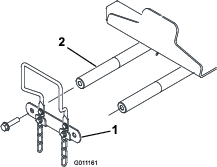
-
Insert a pivot rod into each lift arm and align the mounting holes (Figure 14).
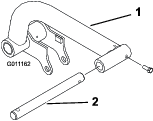
-
Secure the pivot rods to the lift arms with 2 bolts (5/16 x 7/8 inch).
-
Insert the lift arms onto the lift arm pivot shafts (Figure 15), and secure each with a lift arm pivot shaft link and bolts previously removed.
Note: Torque the bolts to 95 N∙m (70 ft-lb).
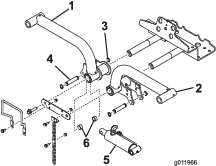
-
Remove the rear retaining rings securing the mounting pins to each end of the lift cylinder.
-
Secure the right end of the lift cylinder to the right lift arm with a pin and 2 spacers (Figure 15). Secure it with a retaining ring.
-
Secure the left end of the lift cylinder to the left lift arm with a pin. Secure it with a retaining ring.
Installing the Carrier Frames to the Cutting Units
-
Remove the cutting units from the cartons. Adjust them as described in the cutting unit operator’s manual.
-
Position a front carrier frame (Figure 16) onto each front cutting unit.
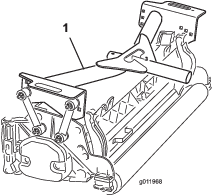
-
Secure the mounting links to the front carrier frames as follows:
-
Secure the front mounting links to the middle carrier frame holes with a bolt (3/8 x 2-1/4 inch), 2 flat washers, and a locknut, as shown in Figure 17. Position a washer on each side of the link when mounting. Torque the fasteners to 42 N∙m (31 ft-lb).
-
Secure the rear mounting links to the middle carrier frame holes with a bolt (3/8 x 2-1/4 inch), 2 flat washers, and a locknut, as shown in Figure 17. Position a washer on each side of the link when mounting. Torque the fasteners to 42 N∙m (31 ft-lb).
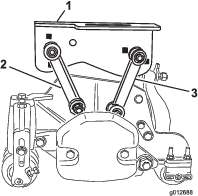
-
-
Position the rear carrier frame (Figure 18) onto the rear cutting unit.
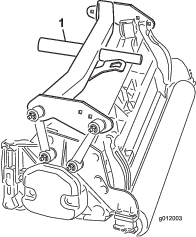
-
Secure the mounting links to the rear carrier frame as follows:
-
Secure the front mounting links to the carrier frame holes with a bolt (3/8 x 2-1/4 inch), 2 flat washers, and a locknut, as shown in Figure 19. Position a washer on each side of the link when mounting. Torque the fasteners to 42 N∙m (31 ft-lb).
-
Secure the rear mounting links to the rear carrier frame holes with a bolt (3/8 x 2-1/4 inch), 2 flat washers, and a locknut, as shown in Figure 19. Position a washer on each side of the link when mounting. Torque the fasteners to 42 N∙m (31 ft-lb).
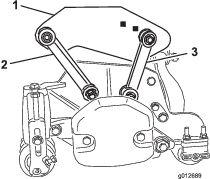
-
Mounting the Cutting Units
-
Slide a thrust washer onto each front lift arm pivot rod.
-
Slide the cutting unit carrier frame onto the pivot rod and secure it with a lynch pin (Figure 20).
Note: On rear cutting unit, position the thrust washer between the rear of the carrier frame and the lynch pin.
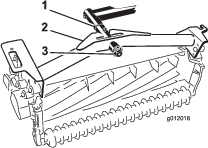
-
Grease all the lift arm and carrier frame pivot points.
Important: Ensure that the hoses are free of twists or sharp bends and that the rear cutting unit hoses are routed as show in (Figure 21). Raise the cutting units and shift them to the left (Model 03171). The rear cutting unit hoses must not contact traction cable bracket. Reposition the fittings and/or hoses, if necessary.
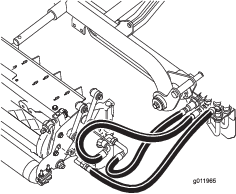
-
Route a tipper chain up through the slot on the end of each carrier frame. Secure the tipper chain to the top of the carrier frame with a bolt, a washer, and a locknut (Figure 22).
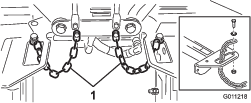
Mounting the Cutting Unit Drive Motors
-
Position the cutting units in front of the lift arm pivot rods.
-
Remove the weight and O-ring (Figure 23) from the inside end of the right cutting unit.
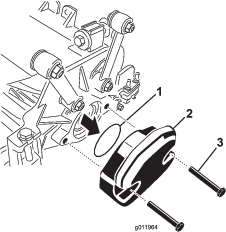
-
Remove the plug from the bearing housing on the outside end of the right cutting unit and install the weights and gasket.
-
Remove the shipping plug from the bearing housings on the remaining cutting units.
-
Insert the O-ring (supplied with the cutting unit) on the flange of the drive motor (Figure 24).
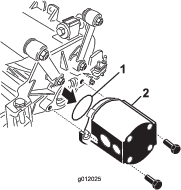
-
Mount the motor to the drive end of the cutting unit, and secure it with 2 cap screws provided with cutting unit (Figure 24).
Adjusting the Lift Arms
-
Start the engine, raise the lift arms, and check to ensure that the clearance between each lift arm and the floor plate bracket is 5 to 8 mm (0.18 to 0.32 inches) (Figure 25).
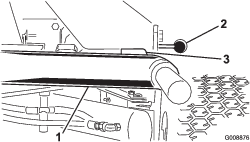
Note: If the clearance is not in this range, adjust the cylinder as follows:
-
Back off the stop bolts and adjust the cylinder to attain the clearance (Figure 26).
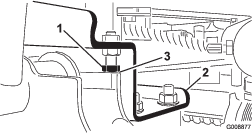
-
Back off the jam nut on the cylinder (Figure 27).

-
Remove the pin from the rod end and rotate the clevis.
-
Install the pin and check the clearance.
-
Repeat steps 1 through 4 if necessary.
-
Tighten the clevis jam nut.
Note: If the rear lift arm clunks during transport, reduce the clearance.
-
-
Check to ensure that the clearance between each lift arm and stop bolt is 0.13 to 1.02 mm (0.005 to 0.040 inches) (Figure 26).
Note: If the clearance is not in this range, adjust the stop bolts to attain clearance.
-
Start the engine, raise the lift arms, and check to ensure that the clearance between the wear strap on the top of the rear cutting unit wear bar and the bumper strap is 0.51 to 2.54 mm (0.02 to 0.10 inches) as shown in Figure 28.

If the clearance is not in this range, adjust the rear cylinder as follows:
-
Lower the cutting units and back off the jam nut on the cylinder (Figure 29).
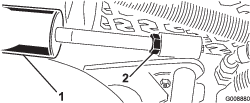
-
Grasp the cylinder rod close to the nut with a pliers and rag and rotate the rod.
-
Raise the cutting units and check the clearance.
-
Repeat steps 1 through 3 if necessary.
-
Tighten the clevis jam nut.
-
Important: Lack of clearance at the front stops or the rear wear bar could damage the lift arms.
Installing the Tipper Roller Kit (Optional)
Parts needed for this procedure:
| Tipper roller kit (not included) | 1 |
When cutting in higher heights of cut, it is recommended that the Tipper Roller Kit be installed.
-
Raise the cutting units all the way up.
-
Locate the frame bracket above the center cutting unit (Figure 30).
-
While pressing down on the front roller of the center cutting unit, determine which holes on the tipper bracket align with the frame bracket holes to attain the same roller contact when the tipper bracket is installed (Figure 30).
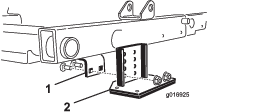
-
Lower the cutting units and mount the tipper bracket to the frame with the 2 carriage bolts and 2 nuts supplied with the kit (Figure 30).
Product Overview

Traction Pedals
Mow/Transport Slide
Using your heel, move the mow/transport slide (Figure 31) to the left to transport and to the right to mow. The cutting units operate only in the mow position.
Important: The mow speed is set at the factory to 9.7 km/h (6 mph). It can be increased or decreased by adjusting the speed stop screw (Figure 32).

Tilt Steering Lever
Pull the tilt steering lever (Figure 31) back to adjust the steering wheel to the desired position, then push the lever forward to tighten.
Indicator Slot
The slot in the operator platform (Figure 31) indicates when the cutting units are in the center position.
Angle Indicator
The angle indicator (Figure 31) indicates the side hill angle of the machine in degrees.
Ignition Switch
The ignition switch (Figure 33), which is used to start, stop, and preheat the engine, has 3 positions: OFF, ON/PREHEAT, and START. Rotate the key to the ON/PREHEAT position until the glow plug indicator light goes out (approximately 7 seconds); then rotate the key to the START position to engage the starter motor. Release the key when the engine starts. The key automatically moves to the ON/RUN position. To shut off the engine, rotate the key to the OFF position and remove the key from the switch to prevent accidental starting.
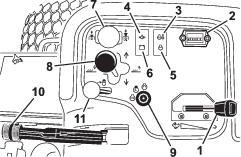
Throttle
Move the throttle (Figure 33) forward to increase the engine speed and rearward to decrease the engine speed.
Cutting Unit Drive Switch
The cutting unit drive switch (Figure 33) has 2 positions: ENGAGE and DISENGAGE. The rocker switch operates a solenoid valve on the valve bank to drive the cutting units.
Hour Meter
The hour meter (Figure 33) indicates the total hours of machine operation. The hour meter starts to function whenever the key switch is on.
Cutting Unit Shift Lever
To lower the cutting units to the ground, move the cutting unit shift lever (Figure 33) forward. The cutting units do not drop unless the engine is running, and they do not operate in the raised position. To raise the cutting units, pull the shift lever rearward to the RAISE position.
Move the lever to the right or left to move the cutting units in the same direction. This should only be done when the cutting units are raised or if they are on the ground and the machine is moving (Model 03171 only).
Note: The lever does not have to be held in the forward position while the cutting units are lowered.
Danger
Shifting the cutting units downhill decreases machine stability. This could cause a rollover, which may result in personal injury or death.
Shift the cutting units uphill while on a side hill.
Engine Coolant Temperature Warning Light
The temperature warning light (Figure 33) glows if the engine coolant temperature is high. If you do not stop the traction unit and the coolant temperature rises another 10°F, the engine shuts off.
Oil Pressure Warning Light
The oil pressure warning light (Figure 33) glows if the engine oil pressure drops below a safe level.
Alternator Light
The alternator light (Figure 33) should be off when the engine is running. If it is on, check and repair the charging system as needed.
Glow Plug Indicator
The glow plug indicator light (Figure 33) glows when the glow plugs are operating.
Parking Brake
Whenever the engine is shut off, engage the parking brake (Figure 33) to prevent accidental movement of the machine. To engage the parking brake, pull up on the lever. The engine stops if you press the traction pedal with the parking brake engaged.
Lift Lever Lock
Move the lift lever lock (Figure 33) rearward to prevent the cutting units from dropping.
Reel Speed Control
The reel speed control is located under the console cover (Figure 34). To obtain the desired clip rate (reel speed), rotate the reel speed control knob to the appropriate height-of-cut setting and mower speed. Refer to Selecting the Clip Rate (Reel Speed).
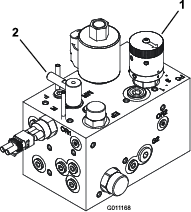
Backlap Control
The backlap control is located under the console cover (Figure 34). Rotate the knob to R for backlapping and to F for mowing. Do not change the knob position while the reels are rotating.
Fuel Gauge
The fuel gauge (Figure 35) registers the amount of fuel in the tank.
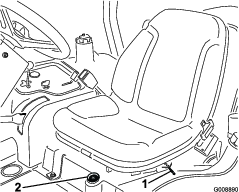
Fore and Aft Seat Adjustments
Move the lever (Figure 35) on the side of the seat outward, slide the seat to the desired position, and release the lever to lock the seat into position.
Note: Specifications and design are subject to change without notice.
| Transport width | 203 cm (80 inches) in 183 cm (72 inches) width of cut234 cm (92 inches) in 216 cm (85 inches) width of cut |
| Width of cut | 183 cm (72 inches) or 216 cm (85 inches) |
| Length | 248 cm (93 inch) |
| Height | 193 cm (76 inches) with ROPS |
| Net weight* | 844 kg (1,860 lb) |
| Fuel tank capacity | 28 L (7.5 US gallons). |
| Ground speed | Mow: 0 to 10 km/h (0 to 6 mph); Transport: 0 to 14 km/h (0 to 9 mph). Reverse: 0 to 6 km/h (0 to 4 mph) |
| * With cutting units and fluids | |
Attachments/Accessories
A selection of Toro approved attachments and accessories is available for use with the machine to enhance and expand its capabilities. Contact your Authorized Service Dealer or authorized Toro distributor or go to www.Toro.com for a list of all approved attachments and accessories.
To ensure optimum performance and continued safety certification of the machine, use only genuine Toro replacement parts and accessories. Replacement parts and accessories made by other manufacturers could be dangerous, and such use could void the product warranty.
Operation
Note: Determine the left and right sides of the machine from the normal operating position.
Before Operation Safety
General Safety
-
Never allow children or untrained people to operate or service the machine. Local regulations may restrict the age of the operator. The owner is responsible for training all operators and mechanics.
-
Become familiar with the safe operation of the equipment, operator controls, and safety signs.
-
Know how to stop the machine and shut off the engine quickly.
-
Check that operator-presence controls, safety switches, and shields are attached and functioning properly. Do not operate the machine unless they are functioning properly.
-
Before mowing, always inspect the machine to ensure that the blades, blade bolts, and cutting assemblies are in good working condition. Replace worn or damaged blades and bolts in sets to preserve balance.
-
Inspect the area where you will use the machine and remove all objects that the machine could throw.
Fuel Safety
-
Use extreme care in handling fuel. It is flammable and its vapors are explosive.
-
Extinguish all cigarettes, cigars, pipes, and other sources of ignition.
-
Use only an approved fuel container.
-
Do not remove the fuel cap or fill the fuel tank while the engine is running or hot.
-
Do not add or drain the fuel in an enclosed space.
-
Do not store the machine or fuel container where there is an open flame, spark, or pilot light, such as on a water heater or other appliance.
-
If you spill fuel, do not attempt to start the engine; avoid creating any source of ignition until the fuel vapors have dissipated.
Checking the Engine-Oil Level
The engine is shipped with oil in the crankcase; however, the oil level must be checked before and after the engine is first started.
The crankcase capacity is approximately 3.8 L (4.0 US qt) with the filter.
Use high-quality engine oil that meets the following specifications:
-
API Classification Level Required: CH-4, CI-4 or higher.
-
Preferred oil: SAE 15W-40 (above -17ºC (0ºF))
-
Alternate oil: SAE 10W-30 or 5W-30 (all temperatures)
Note: Toro Premium Engine oil is available from a distributor in either 15W-40 or 10W-30 viscosity. See the parts catalog for part numbers.
Note: The best time to check the engine oil is when the engine is cool before it has been started for the day. If it has already been run, allow the oil to drain back down to the sump for at least 10 minutes before checking. If the oil level is at or below the Add mark on the dipstick, add oil to bring the oil level to the Full mark. Do not overfill. If the oil level is between the Full and Add marks, you do not need to add oil.
-
Park the machine on a level surface, lower the cutting units, shut off the engine, engage the parking brake, and remove the key from the ignition switch.
-
Remove the dipstick (Figure 36) and wipe it with a clean rag.
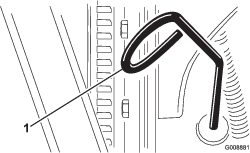
-
Push the dipstick down into the dipstick tube and ensure that it is seated fully, then pull the dipstick out and check the oil level.
-
If the oil level is low, remove the oil-fill cap (Figure 37) and gradually add small quantities of oil, checking the level frequently, until the level reaches the Full mark on the dipstick.
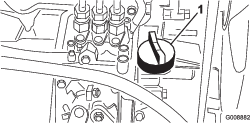
-
Install the oil-fill cap and close the hood.
Important: Keep the engine-oil level between the upper and lower limits on the oil gauge. Engine failure may occur as a result of overfilling or underfilling the engine oil.
Filling the Fuel Tank
Use only clean, fresh diesel fuel or biodiesel fuels with low (<500 ppm) or ultra low (<15 ppm) sulfur content. The minimum cetane rating should be 40. Purchase fuel in quantities that can be used within 180 days to ensure fuel freshness.
The fuel tank capacity is approximately 28 L (7.5 US gallons).
Use summer-grade diesel fuel (No. 2-D) at temperatures above -7°C (20°F) and winter-grade (No. 1-D or No. 1-D/2-D blend) below that temperature. Using winter-grade fuel at lower temperatures provides a lower flash point and cold flow characteristics, which eases starting and reduces plugging of the fuel filter.
Using summer-grade fuel above -7°C (20°F) contributes toward longer fuel pump life and increased power compared to winter grade fuel.
Biodiesel Ready
This machine can also use a biodiesel blended fuel of up to B20 (20% biodiesel, 80% petrodiesel). The petrodiesel portion should be low or ultra low sulfur. Observe the following precautions:
-
The biodiesel portion of the fuel must meet specification ASTM D6751 or EN14214.
-
The blended fuel composition should meet ASTM D975 or EN590.
-
Painted surfaces may be damaged by biodiesel blends.
-
Use B5 (biodiesel content of 5%) or lesser blends in cold weather.
-
Monitor seals, hoses, gaskets in contact with fuel as they may be degraded over time.
-
Fuel filter plugging may be expected for a time after converting to biodiesel blends.
-
Contact a distributor for more information on biodiesel blended fuel.
-
Clean the area around the fuel-tank cap (Figure 38).
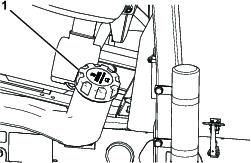
-
Remove the fuel-tank cap.
-
Fill the tank to the bottom of the filler neck.
Note: Do not overfill the fuel tank.
-
Install the cap.
-
Wipe up any spilled fuel.
Checking the Cooling System
| Maintenance Service Interval | Maintenance Procedure |
|---|---|
| Before each use or daily |
|
Clean debris off the radiator daily (Figure 39). Clean the radiator hourly if conditions are extremely dusty and dirty; refer to Cleaning the Engine Cooling System.
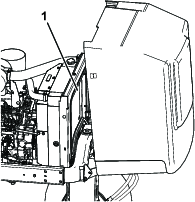
The cooling system is filled with a 50/50 solution of water and permanent ethylene glycol antifreeze. Check the coolant level at the beginning of each day before starting the engine.
The capacity of the cooling system is approximately 5.7 L (6 US qt).
Caution
If the engine has been running, the pressurized, hot coolant can escape and cause burns.
-
Do not open the radiator cap when the engine is running.
-
Use a rag when opening the radiator cap, and open the cap slowly to allow steam to escape.
-
Check the coolant level in the expansion tank (Figure 40).

Note: With a cold engine, the coolant level should be approximately midway between the marks on the side of the tank.
-
If the coolant level is low, remove the expansion tank cap and replenish the system. Do not overfill.
-
Install the expansion tank cap.
Checking the Hydraulic System
| Maintenance Service Interval | Maintenance Procedure |
|---|---|
| Before each use or daily |
|
The hydraulic-fluid tank is filled at the factory with approximately 13.2 L (3.5 US gallons) of high-quality hydraulic fluid. Check the level of the hydraulic fluid before the engine is first started and daily thereafter.
The best time to check the hydraulic fluid is when the fluid is cold. The machine should be in its transport configuration. If the fluid level is below the Add mark on the dipstick, add fluid to bring the fluid level to the middle of the acceptable range. Do not overfill the tank. If the oil level is between the Full and the Add marks, no fluid addition is required.
The recommended replacement fluid is Toro Premium All Season Hydraulic Fluid (Available in 5-gallon pails or 55-gallon drums. Refer to the parts catalog or a Toro distributor for part numbers.)
Alternative fluids: If the Toro fluid is not available, other conventional, petroleum-based fluids may be used, provided that they meet all the following material properties and industry specifications. Check with your oil supplier to see whether the fluid meets these specifications.
Note: Toro will not assume responsibility for damage caused by improper substitutions, so use only products from reputable manufacturers who will stand behind their recommendation.
| High Viscosity Index/Low Pour Point Antiwear Hydraulic Fluid, ISO VG 46 Multigrade | |||
| Material Properties: | |||
| Viscosity, ASTM D445 | cSt @ 40°C (104°F) 44 to 48cSt @ 100°C (212°F) 7.9 to 9.1 | ||
| Viscosity index, ASTM D2270 | 140 or higher (high viscosity index indicates a multiweight fluid) | ||
| Pour point, ASTM D97 | -36.7°C to -45°C (-34°F to -49°F) | ||
| FZG, fail stage | 11 or better | ||
| Water content (new fluid) | 500 ppm (maximum) | ||
| Industry Specifications: | |||
| Vickers I-286-S, Vickers M-2950-S, Denison HF-0, Vickers 35 VQ 25 (Eaton ATS373-C) | |||
The proper hydraulic fluids must be specified for mobile machinery (as opposed to industrial plant usage), multiweight-type, with ZnDTP or ZDDP anti-wear additive package (not an ashless-type fluid).
Important: Many hydraulic fluids are almost colorless, making it difficult to spot leaks. A red dye additive for the hydraulic system fluid is available in 20 ml (2/3 fl oz) bottles. One bottle is sufficient for 15 to 22L (4 to 6 US gallons) of hydraulic fluid. Order Part No. 44-2500 from your Authorized Toro Distributor.
-
Park the machine on a level surface, lower the cutting units, shut off the engine, engage the parking brake, and remove the key from the ignition switch.
-
Clean the area around the filler neck and cap of the hydraulic-fluid tank (Figure 41) and remove the cap.
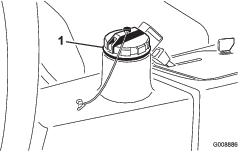
-
Remove the dipstick from the filler neck and wipe it with a clean rag.
-
Insert the dipstick into the filler neck; then remove it and check the fluid level.
Note: The fluid level should be within 6 mm (1/4 inch) of the mark on the dipstick.
-
If the level is low, add the appropriate fluid to raise the level to the full mark.
-
Install the dipstick and cap onto the filler neck.
Checking the Tire Pressure
| Maintenance Service Interval | Maintenance Procedure |
|---|---|
| Before each use or daily |
|
The tires are over-inflated for shipping. Therefore, release some of the air to reduce the pressure. The proper air pressure in the tires is 97 to 124 kPa (14 to 18 psi).
Note: Maintain the recommended pressure in all tires to ensure a good quality of cut and proper machine performance.
Danger
Low tire pressure decreases machine side hill stability. This could cause a rollover, which may result in personal injury or death.
Do not under-inflate the tires.
Checking the Reel-to-Bedknife Contact
| Maintenance Service Interval | Maintenance Procedure |
|---|---|
| Before each use or daily |
|
Check the reel-to-bedknife contact even if the quality of cut had been acceptable previously. There must be light contact across the full length of the reel and bedknife; refer to Adjusting Reel to Bedknife in the cutting unit operator’s manual.
Torquing the Wheel Nuts
| Maintenance Service Interval | Maintenance Procedure |
|---|---|
| After the first hour |
|
| After the first 10 hours |
|
| Every 200 hours |
|
Torque the wheel nuts to 61 to 88 N∙m (45 to 65 ft-lb).
Warning
Failure to maintain proper torque of the wheel nuts could result in personal injury.
Ensure that the wheel nuts are torqued to 61 to 88 N∙m (45 to 65 ft-lb).
During Operation Safety
General Safety
-
The owner/operator can prevent and is responsible for accidents that may cause personal injury or property damage.
-
Wear appropriate clothing, including eye protection; slip-resistant, substantial footwear; long pants; and hearing protection. Tie back long hair and do not wear loose jewelry.
-
Do not operate the machine while ill, tired, or under the influence of alcohol or drugs.
-
Never carry passengers on the machine and keep bystanders and pets away from the machine during operation.
-
Operate the machine only in good visibility to avoid holes or hidden hazards.
-
Avoid mowing on wet grass. Reduced traction could cause the machine to slide.
-
Before you start the engine, ensure that all drives are in neutral, the parking brake is engaged, and you are in the operating position.
-
Keep your hands and feet away from the cutting units. Keep clear of the discharge opening at all times.
-
Look behind and down before backing up to be sure of a clear path.
-
Use care when approaching blind corners, shrubs, trees, or other objects that may obscure your vision.
-
Do not mow near drop-offs, ditches, or embankments. The machine could suddenly roll over if a wheel goes over the edge or if the edge gives way.
-
Stop the cutting units whenever you are not mowing.
-
Stop the machine, shut off the engine, remove the key, and inspect the cutting units after striking an object or if there is an abnormal vibration in the machine. Make all necessary repairs before resuming operation.
-
Slow down and use caution when making turns and crossing roads and sidewalks with the machine. Always yield the right-of-way.
-
Disengage the drive to the cutting unit and shut off the engine before adjusting the height of cut (unless you can adjust it from the operating position).
-
Never run an engine in an area where exhaust gasses are enclosed.
-
Never leave a running machine unattended.
-
Before leaving the operating position (including to empty the catchers or to unclog the chute), do the following:
-
Park the machine on level ground.
-
Disengage the power take-off and lower the attachments.
-
Engage the parking brake.
-
Shut off the engine and remove the key.
-
Wait for all moving parts to stop.
-
-
Do not operate the machine when there is the risk of lightning.
-
Do not use the machine as a towing vehicle.
-
Use accessories, attachments, and replacement parts approved by The Toro® Company only.
Rollover Protection System (ROPS) Safety
-
Do not remove the ROPS from the machine.
-
Ensure that the seat belt is attached and that you can release it quickly in an emergency.
-
Check carefully for overhead obstructions and do not contact them.
-
Keep the ROPS in safe operating condition by thoroughly inspecting it periodically for damage and keeping all the mounting fasteners tight.
-
Replace damaged ROPS components. Do not repair or alter them.
Machines with a Fixed Roll Bar
-
The ROPS is an integral safety device.
-
Always wear your seat belt.
Slope Safety
-
Slopes are a major factor related to loss of control and rollover accidents, which can result in severe injury or death. The operator is responsible for safe slope operation. Operating the machine on any slope requires extra caution.
-
This triplex mower has a unique drive system for superior traction on hills. The uphill wheel does not spin out and limit traction like conventional triplex mowers. If you operate the machine on a side hill that is too steep, rollover will occur before losing traction.
-
When possible, mow up and down a hill rather than across it.
-
On side hills, shift the cutting units uphill (if equipped).
-
If the tires lose traction, disengage the blade(s) and proceed slowly straight down the slope.
-
If you must turn, turn slowly and gradually downhill, if possible.
-
Evaluate the site conditions to determine if the slope is safe for machine operation, including surveying the site. Always use common sense and good judgment when performing this survey.
-
Review the slope instructions listed below for operating the machine on slopes and review the conditions in which you will operate the machine to determine whether you can operate it in the conditions on that day and at that site. Changes in the terrain can result in a change in slope operation for the machine.
-
Avoid starting, stopping, or turning the machine on slopes. Avoid making sudden changes in speed or direction. Make turns slowly and gradually.
-
Do not operate a machine under any conditions where traction, steering, or stability is in question.
-
Remove or mark obstructions such as ditches, holes, ruts, bumps, rocks, or other hidden hazards. Tall grass can hide obstructions. Uneven terrain could overturn the machine.
-
Be aware that operating the machine on wet grass, across slopes, or downhill may cause the machine to lose traction. Loss of traction to the drive wheels may result in sliding and a loss of braking and steering.
-
Use extreme caution when operating the machine near drop offs, ditches, embankments, water hazards or other hazards. The machine could suddenly roll over if a wheel goes over the edge or the edge caves in. Establish a safety area between the machine and any hazard.
-
Identify hazards at the base of the slope. If there are hazards, mow the slope with a pedestrian-controlled machine.
-
If possible, keep the cutting unit(s) lowered to the ground while operating on slopes. Raising the cutting unit(s) while operating on slopes can cause the machine to become unstable.
-
Use extreme caution with grass collection systems or other attachments. These can change the stability of the machine and cause a loss of control.
Starting and Shutting Off the Engine
You may need to bleed the fuel system if any of the following situations have occurred; refer to Bleeding the Fuel System:
-
It is the initial startup of a new engine.
-
The engine has ceased running due to lack of fuel.
-
Maintenance has been performed upon the fuel system components; e.g., filter replaced, etc.
Starting the Engine
-
Ensure that the parking brake is engaged and the reel drive switch is in the DISENGAGE position.
-
Remove your foot from the traction pedal and ensure that the pedal is in the neutral position.
-
Move the throttle lever to the 1/2 throttle position.
-
Insert the key into the switch and rotate it to the ON/PREHEAT position until the glow plug indicator light goes out (approximately 7 seconds); then rotate the key to the START position to engage the starter motor. Release the key when the engine starts.
Note: The key moves automatically to the ON/RUN position.
Important: To prevent overheating of the starter motor, do not engage the starter longer than 15 seconds. After 10 seconds of continuous cranking, wait 60 seconds before engaging the starter motor again.
-
When the engine is started for the first time or after an overhaul of the engine, operate the machine in forward and reverse for 1 to 2 minutes. Also operate the lift lever and cutting unit drive switch to ensure proper operation of all parts.
Note: Turn the steering wheel to the left and right to check the steering response, then shut the engine off and check for oil leaks, loose parts, and any other noticeable malfunctions.
Caution
Checking for oil leaks, loose parts, and other malfunctions could result in injury.
Shut off the engine and wait for all moving parts to stop before checking for oil leaks, loose parts, and other malfunctions.
Shutting Off the Engine
Move the throttle control to the IDLE position, move the reel drive switch to DISENGAGE, and rotate the starter key to OFF.
Note: Remove the key from the switch to prevent accidental starting.
Bleeding the Fuel System
-
Park the machine on a level surface, lower the cutting units, shut off the engine, engage the parking brake, and remove the key from the ignition switch.
-
Ensure that the fuel tank is at least half full.
-
Unlatch and raise the hood.
-
Open the air bleed screw on the fuel-injection pump (Figure 42).
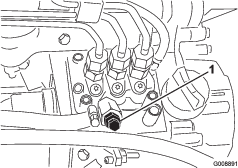
-
Turn the key in the ignition switch to the ON position. The electric fuel pump begins operation, thereby forcing air out around the air bleed screw.
Note: Leave the key in the ON position until a solid stream of fuel flows out around the screw.
-
Tighten the screw and turn the key to off.
Note: Normally the engine should start after following the bleeding procedures above. However, if the engine does not start, air may be trapped between the injection pump and the injectors; refer to Bleeding the Fuel System.
After Operation Safety
-
Clean grass and debris from the cutting units, mufflers, and engine compartment to help prevent fires. Clean up oil or fuel spills.
-
If the cutting units are in the transport position, use the positive mechanical lock (if available) before you leave the machine unattended.
-
Allow the engine to cool before storing the machine in any enclosure.
-
Shut off the fuel before storing or transporting the machine.
-
Never store the machine or fuel container where there is an open flame, spark, or pilot light, such as on a water heater or on other appliances.
-
Keep all parts of the machine in good working condition and all hardware tightened, especially blade-attachment hardware.
-
Replace all worn or damaged decals.
Checking the Interlock System
| Maintenance Service Interval | Maintenance Procedure |
|---|---|
| Before each use or daily |
|
Caution
If the safety interlock switches are disconnected or damaged, the machine could operate unexpectedly, causing personal injury.
-
Do not tamper with the interlock switches.
-
Check the operation of the interlock switches daily and replace any damaged switches before operating the machine.
-
Ensure that all bystanders are away from the area of operation, and keep hands and feet away from the cutting units.
-
While sitting on the seat, the engine must not start with either the cutting unit switch engaged or the traction pedal engaged. Correct the problem if it is not operating properly.
-
While sitting on the seat, put the traction pedal in neutral, disengage the parking brake, and set the cutting unit switch in the OFF position. The engine should start. Rise from the seat and slowly press the traction pedal, and the engine should shut off in 1 to 3 seconds. Correct the problem if it is not operating properly.
Note: The machine is equipped with an interlock switch on the parking brake. The engine shuts off if you press the traction pedal with the parking brake engaged.
Identifying the Tie-Down Points

Hauling the Machine
-
Use full-width ramps for loading the machine onto a trailer or truck.
-
Tie the machine down securely.
Towing the Machine
In case of an emergency, the machine can be towed for a short distance; however, Toro does not recommend this as a standard procedure.
Important: Do not tow the machine faster than 3 to 4 km/h (2 to 3 mph) because it may damage the drive system. If the machine must be moved a considerable distance, transport it on a truck or trailer.
-
Locate the bypass valve on the pump (Figure 44) and rotate it 90°.
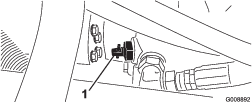
-
Before starting the engine, close the bypass valve by rotating it 90° (1/4 turn). Do not start the engine while the valve is open.
Using the Standard Control Module (SCM)
The Standard Control Module is a potted electronic device produced in a one-size-fits-all configuration. The module uses solid state and mechanical components to monitor and control standard electrical features required for safe product operation.
The module monitors inputs including neutral, parking brake, PTO, start, backlap, and high temperature. The module energizes outputs including PTO, Starter, and ETR (energize to run) solenoid.
The module is divided into inputs and outputs. Inputs and outputs are identified by green LED indicators mounted on the printed circuit board.
The start circuit input is energized by 12 VDC. All other inputs are energized when the circuit is closed to ground. Each input has a LED that is illuminated when the specific circuit is energized. Use the input LEDs for switch and input circuit troubleshooting.
Output circuits are energized by an appropriate set of input conditions. The 3 outputs include PTO, ETR, and START. Output LEDs monitor relay condition indicating the presence of voltage at 1 of 3 specific output terminals.
Output circuits do not determine output device integrity, so electrical troubleshooting includes output LED inspection and conventional device and wire harness integrity testing. Measure the disconnected component impedance, the impedance through wire harness (disconnect at SCM), or by temporarily ”test energizing” the specific component.
The SCM does not connect to an external computer or handheld device, cannot be re-programmed, and does not record intermittent fault troubleshooting data.
The decal on the SCM only includes symbols. Three LED output symbols are shown in the output box. All other LEDs are inputs. The chart below identifies the symbols.

Here are the logical troubleshooting steps for the SCM device.
-
Determine the output fault you are trying to resolve (PTO, START, or ETR).
-
Move the key switch to the ON position and ensure that the red power LED is illuminated.
-
Move all the input switches to ensure that all LEDs change state.
-
Position the input devices at the appropriate position to achieve the appropriate output. Use the following logic chart to determine the appropriate input condition.
-
If the specific output LED is illuminated without the appropriate output function, check the output harness, connections, and component. Repair as needed.
-
If the specific output LED is not illuminated, check both fuses.
-
If the specific output LED is not illuminated and the inputs are in the appropriate condition, install a new SCM and determine if the fault disappears.
Each row (across) in the logic chart below identifies input and output requirements for each specific product function. The product functions are listed in the left column. The symbols identify the specific circuit condition including: energized to voltage, closed to ground, and open to ground.
| INPUTS | OUTPUTS | ||||||||||
|---|---|---|---|---|---|---|---|---|---|---|---|
| Function | Power ON | In Neutral | Start ON | Brake ON | PTO ON | In Seat | Hi Temp | Backlap | Start | ETR | PTO |
| Start | — | — | + | O | O | — | O | O | + | + | O |
| Run (Off Unit) | — | — | O | O | O | O | O | O | O | + | O |
| Run (On Unit) | — | O | O | — | O | — | O | O | O | + | O |
| Mow | — | O | O | — | — | — | O | O | O | + | + |
| Backlap | — | — | O | O | — | O | O | — | O | + | + |
| Hi Temp | — | O | — | O | O | O | |||||
-
(–) Indicates a circuit closed to ground—LED ON.
-
(O) Indicates a circuit open to ground or de-energized—LED OFF.
-
(+) Indicates an energized circuit (clutch coil, solenoid, or start input)—LED ON.
-
A blank indicates a circuit that is not involved with the logic.
To troubleshoot, turn on the key without starting the engine. Identify the specific function that does not work and work across the logic chart. Inspect the condition of each input LED’s to ensure that it matches the logic chart.
If the input LEDs are correct, check the output LED. If the output LED is illuminated but the device is not energized, measure the available voltage at the output device, the continuity of the disconnected device, and the potential voltage on the ground circuit (floating ground). Repairs will vary depending on your findings.
Operating Tips
General Tips for Model 03171
Danger
The mower has a unique traction system that allows the machine to move forward on side hills, even if the uphill wheel should come off the ground. If this should happen, you or any bystanders could be seriously injured or killed in a rollover.
The slope angle at which the machine tips depends on many factors. Among these are mowing conditions such as wet or undulating turf, speed (especially in turns), position of the cutting units (with Sidewinder), tire pressure, and operator experience.
At side hill angles of 15 degrees or less, the risk of a rollover is low. As the slope angle increases to a recommended maximum limit of 25 degrees, the risk of a rollover increases to a moderate level. Do not exceed a 20 degree side hill slope angle because the risk of a rollover and serious injury or death is very high.
To determine which hills or slopes you may safely operate on, you must conduct a site survey of the mowing area. When performing this site survey, always use common sense and take into consideration the turf condition and the rollover risk. To determine which hills or slopes may be safely operated on, use the inclinometer provided with each machine. To perform a site survey, lay a 1.25 m plank (4 ft 2 x 4) on the slope surface and measure the angle of the slope. The 1.25 m plank (4 ft 2 x 4) averages the slope but does not take into consideration dips or holes, which can cause a sudden change in side hill angle. The maximum side hill angle should not be greater than 20 degrees.
Additionally, the machine is equipped with an angle indicator mounted on the steering tube. This indicates the side hill angle the machine is on and identifies the recommended maximum limit of 25 degrees.
-
Practice operating the machine and become thoroughly familiar with it.
-
Start the engine and run it at half idle until it warms up. Push the throttle lever all the way forward, lift the cutting units, disengage the parking brake, press the forward traction pedal, and carefully drive to an open area.
-
Practice moving forward and in reverse, and starting and stopping the machine. To stop the machine, take your foot off the traction pedal and let it return to neutral or press down on the reverse pedal to stop. Going down a hill, you may need to use the reverse pedal to stop.
-
When driving on slopes, drive slowly to maintain steering control and avoid turns to prevent rollovers. In side hill situations you should shift the sidewinder cutting units to the uphill side to give you more stability. Conversely, shifting the cutting units to the down hill side will give you less stability. This should always be done before going on a side hill.
-
When possible, mow up and down hills rather than across them. Have the cutting units lowered when going down a hill to maintain steering control. Do not attempt to turn on a hill.
-
Practice driving around obstacles with the cutting units up and down. Be careful when driving between objects so that you do not damage the machine or cutting units.
-
Get a feel for the reach of the cutting units so that you do not hang them up or damage them in any way.
-
Do not shift the units from side to side, unless the cutting units are down and the machine is moving, or the cutting units are up in the transport position. Shifting the cutting units when they are down and the machine is not moving may damage the turf.
-
Always drive slowly in rough areas.
-
If a person appears in or near the operating area, stop the machine, and do not start it again until the area is cleared. The machine is designed for 1 person. Never let anyone else ride on the machine with you. This is extremely dangerous and could result in serious injury.
-
Accidents can happen to anyone. The most common causes are excessive speed, sudden turns, terrain (not knowing which slopes and hills can be mowed safely), not stopping the engine before leaving the operator’s seat, and drugs that impair your alertness. Cold capsules or prescription drugs may cause drowsiness, as can alcohol and other drugs. Stay alert and stay safe. Failure to do so could result in serious injury.
-
Do not operate the mower if tired, ill, or under the influence of alcohol or drugs.
-
The Sidewinder offers up to a maximum of 33 cm (13 inches) of overhang, allowing you to trim closer to the edge of sand traps and other obstacles, while at the same time keeping the tractor tires as far away from the edge of traps or water hazards as possible.
-
If an obstacle is in the way, shift the cutting units to easily mow around it.
-
When transporting the machine from 1 work area to another, raise the cutting units to the fully up position, move the mow/transport slide to the left to transport, and place the throttle in the FAST position.
General Tips for Model 03170
Danger
The mower has a unique traction system that allows the machine to move forward on side hills, even if the uphill wheel should come off the ground. If this should happen, you or any bystanders could be seriously injured or killed in a rollover.
The slope angle at which the machine tips depends on many factors. Among these are mowing conditions such as wet or undulating turf, speed (especially in turns), position of the cutting units, tire pressure, and operator experience.
At side hill angles of 20 degrees or less, the risk of a rollover is low. As the slope angle increases to a recommended maximum limit of 25 degrees, the risk of a rollover increases to a moderate level. Do not exceed a 25 degree side hill slope angle because the risk of a rollover and serious injury or death is very high.
To determine which hills or slopes you may safely operate on, you must conduct a site survey of the mowing area. When performing this site survey, always use common sense and take into consideration the turf condition and the rollover risk. To determine which hills or slopes may be safely operated on, use the inclinometer provided with each machine. To perform a site survey, lay a 1.25 m plank (4 ft 2 x 4) on the slope surface and measure the angle of the slope. The 1.25 m plank (4 ft 2 x 4) averages the slope but does not take into consideration dips or holes, which can cause a sudden change in side hill angle. The maximum side hill angle should not be greater than 25 degrees.
Additionally, the machine is equipped with an angle indicator mounted on the steering tube. This indicates the side hill angle the machine is on and identifies the recommended maximum limit of 25 degrees.
-
Practice operating the machine and become thoroughly familiar with it.
-
Start the engine and run it at half idle until it warms up. Push the throttle lever all the way forward, lift the cutting units, disengage the parking brake, press the forward traction pedal, and carefully drive to an open area.
-
Practice moving forward and reverse, and starting and stopping the machine. To stop the machine, take your foot off the traction pedal and let it return to neutral or press down on the reverse pedal to stop. Going down a hill, you may need to use the reverse pedal to stop.
-
When driving on slopes, drive slowly to maintain steering control and avoid turns to prevent rollovers.
-
When possible, mow up and down hills rather than across them. Have the cutting units lowered when going down a hill to maintain steering control. Do not attempt to turn on a hill.
-
Practice driving around obstacles with the cutting units up and down. Be careful when driving between objects so that you do not damage the machine or cutting units.
-
Get a feel for the reach of the cutting units so that you do not hang them up or damage them in any way.
-
Always drive slowly in rough areas.
-
If a person appears in or near the operating area, stop the machine, and do not start it again until the area is cleared. The machine is designed for 1 person. Never let anyone else ride on the machine with you. This is extremely dangerous and could result in serious injury.
-
Accidents can happen to anyone. The most common causes are excessive speed, sudden turns, terrain (not knowing which slopes and hills can be mowed safely), not stopping the engine before leaving the operator’s seat, and drugs that impair your alertness. Cold capsules or prescription drugs may cause drowsiness, as can alcohol and other drugs. Stay alert and stay safe. Failure to do so could result in serious injury.
-
Do not operate the mower if tired, ill, or under the influence of alcohol or drugs.
-
When transporting the machine from 1 work area to another, raise the cutting units to the fully up position, move the mow/transport slide to the left to transport, and place the throttle in the FAST position.
Mowing Techniques
-
To begin cutting, engage the cutting units, then approach the mowing area slowly. Once the front cutting units are over the mowing area, lower the cutting units.
-
To achieve the professional straight-line cut and striping that is desirable for some applications, find a tree or other object in the distance and drive straight toward it.
-
As soon as the front cutting units reach the edge of the mowing area, lift the cutting units and perform a tear drop shaped turn to quickly line you up for your next pass.
-
To mow around bunkers, ponds, or other contours easily, use the Sidewinder and move the control lever left or right, depending on your mowing application. The cutting units can also be shifted to vary tire tracking.
-
The cutting units tend to throw grass to the front or the rear of the machine. Front throw should be used when cutting smaller amounts of grass; thus, leaving a better after-cut appearance. To throw clippings to the front, simply close the rear shield on the cutting units.
Caution
To prevent personal injury or damage to the machine, do not open or close the cutting unit shields while the engine is running.
Shut off the engine and wait for all moving parts to stop before opening or closing the cutting unit shields.
-
When cutting larger amounts of grass, position the shields to just below horizontal. Do not open the shields too far or an excessive amount of clippings could build up on the frame, rear radiator screen, and engine area.
-
The cutting units are also equipped with balance weights on the non-motor end to give an even cut. You can add or remove weights if a mismatch occurs on your turf.
After Mowing
After mowing, thoroughly wash the machine with a garden hose without a nozzle to prevent excessive water pressure from prevent contamination and damage to the seals and bearings. Ensure that the radiator and oil cooler are kept free of dirt or grass clippings. After cleaning, inspect the machine for possible hydraulic fluid leaks, damage, or wear to the hydraulic and mechanical components. Check the cutting unit blades to ensure that they are sharp and that the reel-to-bedknife contact is properly adjusted.
Important: After washing the machine, move the Sidewinder mechanism from left to right several times to remove the water between the bearing blocks and the cross tube (Model 03171 only).
Selecting the Clip Rate (Reel Speed)
To achieve a consistent, high quality of cut and a uniform after-cut appearance, it is important that the reel speed be matched to the height of cut.
Important: If the reel speed is too slow, you may notice visible clip marks. If the reel speed is too fast, the cut may have a fuzzy appearance.
Adjust the clip rate (reel speed) as follows:
-
Verify the height-of-cut setting on the cutting units. Use the column of the chart listing either 5 or 8 reels, and find the height-of-cut listing nearest the actual height-of-cut setting. Look across the chart to find the number that corresponds to that height of cut.
REEL SPEED SELECTION CHART Height of Cut 5-Blade Reel 8-Blade Reel 11-Blade Reel 8 km/h(5 mph) 9.6 km/h(6 mph) 8 km/h(5 mph) 9.6 km/h(6 mph) 8 km/h(5 mph) 9.6 km/h(6 mph) 63.5 mm 2-1/2 inches 3 3 3* 3* – – 60.3 mm 2-3/8 inches 3 4 3* 3* – – 57.2 mm 2-1/4 inches 3 4 3* 3* – – 54.0 mm 2-1/8 inches 3 4 3* 3* – – 50.8 mm 2 inches 3 4 3* 3* – – 47.6 mm 1-7/8 inches 4 5 3* 3* – – 44.5 mm 1-3/4 inches 4 5 3* 3* – – 41.3 mm 1-5/8 inches 5 6 3* 3* – – 38.1 mm 1-1/2 inches 5 7 3 4 – – 34.9 mm 1-3/8 inches 5 8 3 4 – – 31.8 mm 1-1/4 inches 6 9 4 4 – – 28.8 mm 1-1/8 inches 8 9* 4 5 – – 25. mm 1 inch 9 9* 5 6 – – 22.2 mm 7/8 inch 9* 9* 5 7 – – 19.1 mm 3/4 inch 9* 9* 7 9 6 7 15.9 mm 5/8 inch 9* 9* 9 9* 7 7 12.7 mm 1/2 inch 9* 9* 9 9* 8 8 9.5 mm 3/8 inch 9* 9* 9 9* 9 9 * Toro does not recommend this height of cut and/or mowing speed.
Note: The higher the number, the higher the speed.
-
Turn the reel speed control knob (Figure 46) to the number setting determined in Step 1.
-
Operate the machine for several days, then examine the cut to ensure the quality of cut. The reel speed knob may be set 1 position on either side of the position indicated on the chart to account for differences in grass condition, grass length removed, and personal preference.

Maintenance
Note: Determine the left and right sides of the machine from the normal operating position.
Recommended Maintenance Schedule(s)
| Maintenance Service Interval | Maintenance Procedure |
|---|---|
| After the first hour |
|
| After the first 10 hours |
|
| After the first 50 hours |
|
| Before each use or daily |
|
| Every 25 hours |
|
| Every 50 hours |
|
| Every 100 hours |
|
| Every 150 hours |
|
| Every 200 hours |
|
| Every 400 hours |
|
| Every 500 hours |
|
| Every 2 years |
|
Caution
If you leave the key in the ignition switch, someone could accidently start the engine and seriously injure you or bystanders.
Remove the key from the ignition before you do any maintenance.
Service Interval Chart

Pre-Maintenance Procedures
Pre-Maintenance Safety
-
Before adjusting, cleaning, repairing, or leaving the machine, do the following:
-
Park the machine on a level surface.
-
Move the throttle switch to the low-idle position.
-
Disengage the cutting units.
-
Lower the cutting units.
-
Ensure that the traction is in neutral.
-
Engage the parking brake.
-
Shut off the engine and remove the key.
-
Wait for all moving parts to stop.
-
Allow machine components to cool before performing maintenance.
-
-
If possible, do not perform maintenance while the engine is running. Keep away from moving parts.
-
Use jack stands to support the machine or components when required.
-
Carefully release pressure from components with stored energy.
Removing the Hood
The hood may be easily removed to ease maintenance procedures in the engine area of the machine.
-
Unlatch and raise the hood.
-
Remove the cotter pin that secures the hood pivot to the mounting brackets (Figure 48).
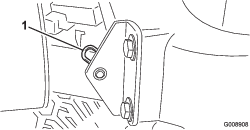
-
Slide the hood to the right side, lift the other side, and pull it out of the brackets.
Note: Reverse the procedure to install the hood.
Lubrication
Greasing the Bearings And Bushings
| Maintenance Service Interval | Maintenance Procedure |
|---|---|
| Every 50 hours |
|
| Every 500 hours |
|
The machine has grease fittings that must be lubricated regularly with No. 2 lithium grease. Lubricate the bearings and bushings daily when the operating conditions are extremely dusty and dirty. Dusty and dirty operating conditions could cause dirt to get into the bearings and bushings, resulting in accelerated wear. Lubricate the grease fittings immediately after every washing, regardless of the interval specified.
The grease fitting locations and quantities are as follows:
-
Rear cutting unit pivot (Figure 49)
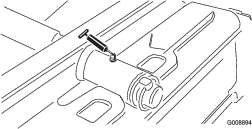
-
Front cutting unit pivot (Figure 50)
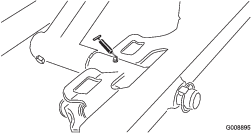
-
SideWinder cylinder ends (2; Model 03171 only) (Figure 51)
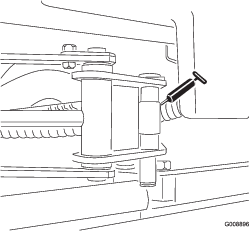
-
Steering pivot (Figure 52)
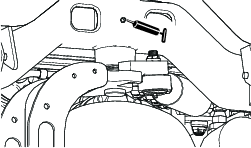
-
Rear lift arm pivot and lift cylinder (2) (Figure 53)
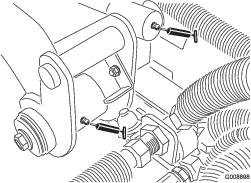
-
Left front lift arm pivot and lift cylinder (2) (Figure 54)
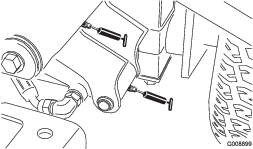
-
Right front lift arm pivot and lift cylinder (2) (Figure 55)
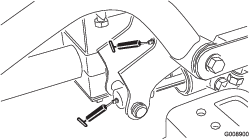
-
Neutral adjust mechanism (Figure 56)
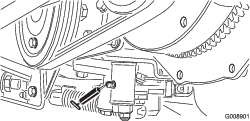
-
Mow/transport slide (Figure 57)

-
Belt tension pivot (Figure 58)
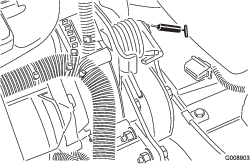
-
Steering cylinder (Figure 59).
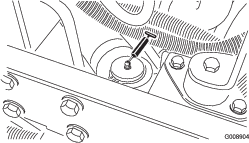
Note: If desired, install an additional grease fitting in the other end of the steering cylinder. Remove the tire, install the fitting, grease the fitting, remove the fitting, and install the plug (Figure 60).
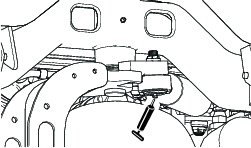
Checking the Sealed Bearings
Bearings rarely fail from defects in materials or workmanship. The most common reason for failure is moisture and contamination working its way past the protective seals. Bearings that are greased rely upon regular maintenance to purge harmful debris from the bearing area. Sealed bearings rely on an initial fill of special grease and a robust integral seal to keep contaminants and moisture out of the rolling elements.
The sealed bearings require no lubrication or short-term maintenance. This minimizes routine service required and reduces the potential of turf damage due to grease contamination. These sealed bearing packages will provide good performance and life under normal use, but periodic inspections of bearing condition and seal integrity should be conducted to avoid downtime. These bearings should be inspected seasonally and replaced if they are damaged or worn. Bearings should operate smoothly with no detrimental characteristics such as high heat, noise, looseness, or indications of corrosion (rust).
Due to the operating conditions these bearing/seal packages are subject to (i.e., sand, turf chemicals, water, impacts, etc.) they are considered normal wear items. Bearings that fail due to causes other than defects in materials or workmanship are typically not covered under the warranty.
Note: Bearing life can be negatively affected by improper wash-down procedures. Do not wash down the machine when it is still hot and avoid directing high-pressure or high-volume spray at the bearings.
Engine Maintenance
Engine Safety
-
Shut off the engine before checking the oil or adding oil to the crankcase.
-
Do not change the governor speed or overspeed the engine.
Servicing the Air Cleaner
| Maintenance Service Interval | Maintenance Procedure |
|---|---|
| Every 200 hours |
|
-
Check the air cleaner body for damage which could cause an air leak. Replace it if it is damaged. Check the whole intake system for leaks, damage, or loose hose clamps.
-
Service the air cleaner at the recommended service interval or earlier if engine performance suffers due to extremely dusty, dirty conditions. Changing the air filter before it is necessary only increases the chance of dirt entering the engine when the filter is removed.
-
Ensure that the cover is seated correctly and seals with the air-cleaner body.
-
Release the latches that secure the air-cleaner cover to the air-cleaner body (Figure 61).
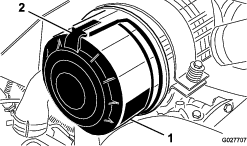
-
Remove the cover from the air-cleaner body.
-
Before removing the filter, use low-pressure air—276 kPa (40 psi), clean and dry—to help remove large accumulations of debris packed between the outside of primary filter and the canister. Avoid using high-pressure air which could force dirt through the filter into the intake tract. This cleaning process prevents debris from migrating into the intake when you remove the primary filter.
-
Remove and replace the primary filter (Figure 62).
Note: Cleaning the used element may damage the filter media.
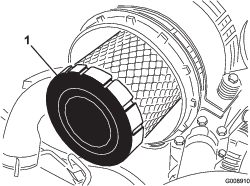
-
Inspect the new filter for shipping damage and check the sealing end of the filter and the body. Do not use a damaged element.
-
Insert the new filter by applying pressure to the outer rim of the element to seat it in the canister. Do not apply pressure to the flexible center of the filter.
-
Clean the dirt ejection port located in the removable cover.
-
Remove the rubber outlet valve from the cover, clean the cavity, and replace the outlet valve.
-
Install the cover orienting the rubber outlet valve in a downward position—between approximately 5 o'clock to 7 o'clock when viewed from the end.
-
Secure the cover latches.
Changing the Engine Oil and the Filter
| Maintenance Service Interval | Maintenance Procedure |
|---|---|
| After the first 50 hours |
|
| Every 150 hours |
|
-
Remove either drain plug (Figure 63) and let the oil flow into a drain pan; when the oil stops flowing, install the drain plug.
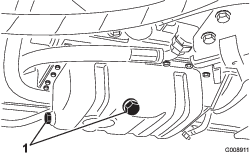
-
Remove the oil filter (Figure 64).
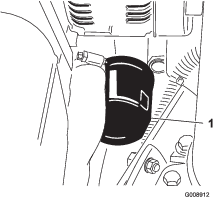
-
Apply a light coat of clean oil to the new filter seal and install the oil filter.
Note: Do not overtighten the filter.
-
Add oil to the crankcase; refer to Checking the Engine-Oil Level.
Fuel System Maintenance
Danger
Under certain conditions, diesel fuel and fuel vapors are highly flammable and explosive. A fire or an explosion from fuel can burn you and others and can cause property damage.
-
Use a funnel and fill the fuel tank outdoors, in an open area, when the engine is off and is cold. Wipe up any fuel that spills.
-
Do not fill the fuel tank completely full. Add fuel to the fuel tank until the level is 6 to 13 mm (1/4 to 1/2 inch) below the bottom of the filler neck. This empty space in the tank allows the fuel to expand.
-
Never smoke when handling fuel, and stay away from an open flame or where fuel fumes may be ignited by a spark.
-
Store fuel in a clean, safety-approved container, and keep the cap in place.
Servicing the Fuel Tank
| Maintenance Service Interval | Maintenance Procedure |
|---|---|
| Every 2 years |
|
Drain and clean the tank if the fuel system becomes contaminated or if the machine will be stored for an extended period of time. Use clean fuel to flush out the tank.
Inspecting the Fuel Lines and Connections
| Maintenance Service Interval | Maintenance Procedure |
|---|---|
| Every 400 hours |
|
Inspect the fuel lines and connections for deterioration, damage, or loose connections.
Draining the Water Separator
| Maintenance Service Interval | Maintenance Procedure |
|---|---|
| Before each use or daily |
|
-
Place a clean container under the fuel filter.
-
Loosen the drain valve on the bottom of the filter canister (Figure 65).
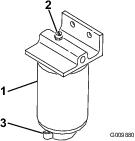
-
Tighten the valve after draining.
Changing the Fuel Filter Canister
| Maintenance Service Interval | Maintenance Procedure |
|---|---|
| Every 400 hours |
|
-
Clean the area where the filter canister mounts (Figure 65).
-
Remove the filter canister and clean the mounting surface.
-
Lubricate the gasket on the filter canister with clean oil.
-
Install the filter canister by hand until the gasket contacts the mounting surface; then rotate an additional 1/2 turn.
Bleeding Air from the Injectors
Note: Perform this procedure only when the fuel system has been purged of air through normal priming procedures and the engine does not start; refer to Bleeding the Fuel System.
-
Loosen the pipe connection to the #1 nozzle and holder assembly.
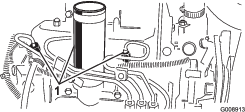
-
Move the throttle to the FAST position.
-
Turn the key in the key switch to the START position and watch the fuel flow around the connector. Turn the key to the OFF position when you see a solid flow.
-
Tighten the pipe connector securely.
-
Repeat this procedure on the remaining nozzles.
Electrical System Maintenance
Electrical System Safety
-
Disconnect the battery before repairing the machine. Disconnect the negative terminal first and the positive last. Connect the positive terminal first and the negative last.
-
Charge the battery in an open, well-ventilated area, away from sparks and flames. Unplug the charger before connecting or disconnecting the battery. Wear protective clothing and use insulated tools.
Servicing the Battery
| Maintenance Service Interval | Maintenance Procedure |
|---|---|
| Every 25 hours |
|
The battery electrolyte level must be properly maintained and the top of the battery kept clean. If the machine is stored in a location where temperatures are extremely high, the battery will run down more rapidly than if the machine is stored in a location where temperatures are cool.
Danger
Battery electrolyte contains sulfuric acid which is a deadly poison and causes severe burns.
-
Do not drink electrolyte and avoid contact with skin, eyes or clothing. Wear safety glasses to shield your eyes and rubber gloves to protect your hands.
-
Fill the battery where clean water is always available for flushing the skin.
-
Charge the battery in a well-ventilated place so that the gasses produced while charging can dissipate.
-
Since the gases are explosive, keep open flames and electrical sparks away from the battery; do not smoke.
-
Nausea may result if the gases are inhaled.
-
Unplug the charger from the electrical outlet before connecting to or disconnecting the charger leads from the battery posts.
Maintain the cell level with distilled or demineralized water. Do not fill the cells above the bottom of the split ring inside each cell. Install the filler caps with the vents pointing to the rear (toward the fuel tank).
Keep the top of the battery clean by washing it periodically with a brush dipped in ammonia or bicarbonate of soda solution. Flush the top surface with water after cleaning. Do not remove the filler caps while cleaning.
The battery cables must be tight on the terminals to provide good electrical contact.
If corrosion occurs at the terminals, disconnect the cables, negative (–) cable first, and scrape the clamps and terminals separately. Connect the cables, positive (+) cable first, and coat the terminals with petroleum jelly.
Storing the Battery
If the machine will be stored more than 30 days, remove the battery and charge it fully. Either store it on the shelf or on the machine. Leave the cables disconnected if they are stored on the machine. Store the battery in a cool atmosphere to avoid quick deterioration of the charge in the battery. To prevent the battery from freezing, ensure that it is fully charged. The specific gravity of a fully charged battery is 1.265 to 1.299.
Checking the Fuses
The fuses are located under the console cover of the machine.
Drive System Maintenance
Adjusting the Traction Drive for Neutral
If the machine moves when the traction pedal is in the neutral position, adjust the traction cam.
-
Park the machine on a level surface, lower the cutting units, shut off the engine, engage the parking brake, and remove the key from the ignition switch.
-
Raise 1 front wheel and 1 rear wheel off the floor and place support blocks under the frame.
Note: 1 front wheel and rear wheel must be raised off the ground or the machine will move during the adjustment.
-
Loosen locknut on traction adjustment cam (Figure 67).
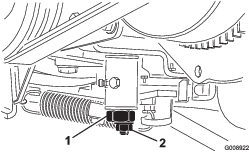
-
Start the engine and rotate the cam hex in both directions to determine mid-position of neutral span.
-
Tighten the locknut that secures the adjustment.
-
Shut off the engine.
-
Remove the support blocks and lower the machine to the shop floor. Test drive the machine to ensure that it does not creep.
Cooling System Maintenance
Cooling System Safety
-
Swallowing engine coolant can cause injury or death; keep out of reach from children and pets.
-
Discharge of hot, pressurized coolant or touching a hot radiator and surrounding parts can cause severe burns.
-
Always allow the engine to cool at least 15 minutes before removing the radiator cap.
-
Use a rag when opening the radiator cap, and open the cap slowly to allow steam to escape.
-
Cleaning the Engine Cooling System
| Maintenance Service Interval | Maintenance Procedure |
|---|---|
| Before each use or daily |
|
| Every 2 years |
|
Remove debris from the oil cooler and radiator daily. Clean them more frequently in dirty conditions.
-
Park the machine on a level surface, lower the cutting units, shut off the engine, engage the parking brake, and remove the key from the ignition switch.
-
Raise the hood.
-
Clean the engine area thoroughly of all debris.
-
Remove the access panel.
-
Clean both sides of the radiator area thoroughly with water or compressed air (Figure 68).

-
Install the access panel and close the hood.
Brake Maintenance
Adjusting the Parking Brake
| Maintenance Service Interval | Maintenance Procedure |
|---|---|
| Every 200 hours |
|
-
Loosen the set screw that secures the knob to the parking brake lever (Figure 69).
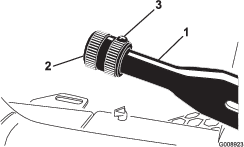
-
Rotate the knob until you produce a force of 41 to 68 N∙m (30 to 40 ft-lb) needed to actuate the lever.
-
Tighten the set screw after attaining the adjustment.
Belt Maintenance
Servicing the Engine Belts
| Maintenance Service Interval | Maintenance Procedure |
|---|---|
| After the first 10 hours |
|
| Every 100 hours |
|
Tensioning the Alternator/Fan Belt
-
Open the hood.
-
Check the tension by depressing the alternator/fan belt midway between the alternator and crankshaft pulleys with 30 N∙m (22 ft-lb) of force (Figure 70).
Note: The belt should deflect 11 mm (7/16 inch).
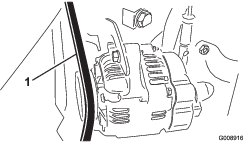
-
If the deflection is incorrect, complete the following procedure to tension the belt:
-
Loosen the bolt that secures the brace to the engine and the bolt that secures the alternator to the brace.
-
Insert a pry bar between the alternator and the engine and pry out on the alternator.
-
When you achieve the proper belt tension, tighten the alternator and brace bolts to secure the adjustment.
-
Replacing the Hydrostat Drive Belt
-
Insert a nut driver or small piece of tubing onto the end of the belt tensioning spring.
Warning
Use caution when de-tensioning the spring, as it is under a heavy load.
-
Push down and forward on the spring end (Figure 71) to unhook it from the bracket and release tension on the spring.
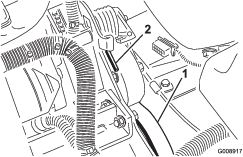
-
Replace the belt.
-
Reverse the procedure to tension the spring.
Controls System Maintenance
Adjusting the Throttle
-
Position the throttle lever rearward so that it stops against the control panel slot.
-
Loosen the throttle cable connector on the injection-pump lever arm (Figure 72).
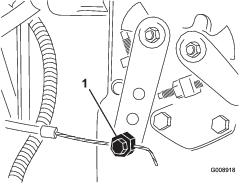
-
Hold the injection-pump lever arm against the low idle stop and tighten the cable connector.
-
Loosen the screws securing the throttle control to the control panel.
-
Push the throttle control lever all the way forward.
-
Slide the stop plate until it contacts the throttle lever, and tighten the screws that secure the throttle control to the control panel.
-
If the throttle does not stay in position during operation, torque the locknut used to set the friction device on the throttle lever to 5 to 6 N∙m (40 to 55 inch-lb).
Note: The maximum force required to operate the throttle lever should be 27 N∙m (20 ft-lb).
Hydraulic System Maintenance
Hydraulic System Safety
-
Seek immediate medical attention if fluid is injected into skin. Injected fluid must be surgically removed within a few hours by a doctor.
-
Ensure that all hydraulic-fluid hoses and lines are in good condition and all hydraulic connections and fittings are tight before applying pressure to the hydraulic system.
-
Keep your body and hands away from pinhole leaks or nozzles that eject high-pressure hydraulic fluid.
-
Use cardboard or paper to find hydraulic leaks.
-
Safely relieve all pressure in the hydraulic system before performing any work on the hydraulic system.
Changing the Hydraulic Fluid
| Maintenance Service Interval | Maintenance Procedure |
|---|---|
| Every 400 hours |
|
If the fluid becomes contaminated, contact a Toro distributor to flush the hydraulic system. Contaminated hydraulic fluid looks milky or black when compared to clean fluid.
-
Turn the engine off and raise the hood.
-
Disconnect the hydraulic line (Figure 73) or remove the hydraulic filter (Figure 74) and let the hydraulic fluid flow into a drain pan.
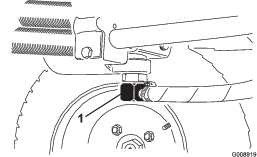
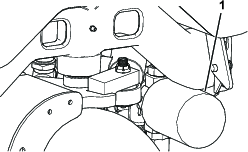
-
Install the hydraulic line when hydraulic fluid stops draining.
-
Fill the reservoir (Figure 75) with approximately 13.2 L (3.5 US gallons) of hydraulic fluid; refer to Checking the Hydraulic System.
Important: Use only the hydraulic fluids specified. Other fluids could damage the hydraulic system.

-
Install the reservoir cap, start the engine, and use all of the hydraulic controls to distribute the hydraulic fluid throughout the system.
-
Check for leaks; then shut off the engine.
-
Check the fluid level and add enough to raise the level to Full mark on the dipstick. Do not overfill.
Changing the Hydraulic Filter
| Maintenance Service Interval | Maintenance Procedure |
|---|---|
| After the first 10 hours |
|
| Every 200 hours |
|
Use a genuine Toro replacement filter (Part No. 54-0110).
Important: Using any other filter may void the warranty on some components.
-
Park the machine on a level surface, lower the cutting units, shut off the engine, engage the parking brake, and remove the key from the ignition switch.
-
Pinch off the hose to the filter mounting plate.
-
Clean around the filter mounting area.
-
Place a drain pan under the filter (Figure 74) and remove the filter.
-
Lubricate the new filter gasket and fill the filter with hydraulic fluid.
-
Ensure that the filter mounting area is clean, screw the filter on until the gasket contacts the mounting plate, and then tighten the filter 1/2 turn.
-
Release the hose to the filter mounting plate.
-
Start the engine and let it run for about 2 minutes to purge the air from the system.
-
Shut off the engine and check for leaks.
Checking the Hydraulic Lines and Hoses
| Maintenance Service Interval | Maintenance Procedure |
|---|---|
| Before each use or daily |
|
Check hydraulic lines and hoses for leaks, kinked lines, loose mounting supports, wear, loose fittings, weather deterioration, and chemical deterioration. Make all necessary repairs before operating.
Warning
Hydraulic fluid escaping under pressure can penetrate skin and cause injury.
-
Ensure that all hydraulic fluid hoses and lines are in good condition and all hydraulic connections and fittings are tight before applying pressure to the hydraulic system.
-
Keep your body and hands away from pin hole leaks or nozzles that eject high-pressure hydraulic fluid.
-
Use cardboard or paper to find hydraulic leaks.
-
Safely relieve all pressure in the hydraulic system before performing any work on the hydraulic system.
-
Seek immediate medical attention if fluid is injected into skin.
Cutting Unit System Maintenance
Cutting Unit Safety
A worn or damaged cutting unit can break, and a piece of a reel or bedknife could be thrown at you or bystanders, resulting in serious personal injury or death.
-
Inspect the cutting units periodically for wear or damage.
-
Use care when checking the cutting units. Wrap the blades or wear gloves, and use caution when servicing the reels and bedknives. Only replace or sharpen the reels and bedknives; never straighten or weld them.
-
On multi-bladed machines, take care as rotating 1 reel can cause other blades to rotate.
Backlapping the Cutting Units
Danger
Contacting the reels may cause personal injury or death.
-
Never place your hands or feet in the reel area while the engine is running.
-
While backlapping, the reels may stall and then start again.
-
Do not attempt to start reels again with your hand or foot.
-
Do not adjust the reels while the engine is running.
-
If the reel stalls, shut off the engine before attempting to clear the reel.
-
Park the machine on a clean and level surface, lower the cutting units, shut off the engine, engage the parking brake, and remove the key from the ignition switch.
-
Remove the console cover to expose the controls.
-
Rotate the backlap control to the backlap position (R). Rotate the reel speed control to position 1 (Figure 76).

Note: The seat switch is bypassed when the backlap control is in the backlap position. You do not need to be in the seat, but the parking brake must be engaged for the engine to run.
Important: Do not rotate the backlap control from the mow position to the backlap position while engine is running. Otherwise, you may damage the reels.
-
Make the initial reel-to-bedknife adjustments appropriate for backlapping on all cutting units. Start the engine and set it to low idle speed.
-
Engage the reels by engaging the PTO switch on the control panel.
-
Apply lapping compound with long-handled brush.
-
To adjust the cutting units while backlapping, disengage the reels and turn the engine off. After you have made the adjustments, repeat steps 4 through 6.
-
After backlapping, shut off the engine, rotate the backlap control to the mow position (F), set the reel speed controls to the desired mowing setting, and wash all the lapping compound off the cutting units.
Note: Additional instructions and procedures on backlapping are available in the Toro Reel Mower Basics (with sharpening guidelines), Form 09168SL.
Note: For a better cutting edge, run a file across the front face of the bedknife after lapping. This removes any burrs or rough edges that may have built up on the cutting edge.
Storage
Preparation for Seasonal Storage
Follow these procedures anytime you will be storing the machine for more than 30 days.
Preparing the Traction Unit
-
Thoroughly clean the traction unit, cutting units, and engine.
-
Check the tire pressure. Inflate all tires to 97 to 110 kPa (14 to 18 psi).
-
Check for loose fasteners and tighten them as necessary.
-
Grease or oil all grease fittings and pivot points. Wipe up any excess lubricant.
-
Lightly sand and use touch-up paint on painted areas that are scratched, chipped, or rusted. Repair any dents in the metal body.
-
Service the battery and cables as follows:
-
Remove the battery terminals from the battery posts.
-
Remove the battery.
-
Slowly charge the battery before storage and every 60 days thereafter for 24 hours to prevent lead sulfation of the battery.
Note: To prevent the battery from freezing, ensure that it is fully charged. The specific gravity of a fully charged battery is 1.265 to 1.299.
-
Clean the battery, terminals, and posts with a wire brush and baking soda solution.
-
Coat the cable terminals and battery posts with Grafo 112X skin-over grease (Toro Part 505-47) or petroleum jelly to prevent corrosion.
-
Either store the battery on the shelf or on the machine in a cool area. Leave the cables disconnected if the battery is stored on the machine.
-
Preparing the Engine
-
Drain the engine oil from the engine and install the drain plug.
-
Remove and discard the oil filter.
-
Install a new oil filter.
-
Fill the engine with approximately 3.8 L (4 US qt) of SAE 15W-40 motor oil.
-
Start the engine and run it at idle speed for approximately 2 minutes.
-
Shut off the engine.
-
Thoroughly drain all the fuel from the fuel tank, fuel lines, fuel filter, and water-separator assembly.
-
Flush the fuel tank with fresh, clean diesel fuel.
-
Secure all the fuel-system fittings.
-
Thoroughly clean and service the air-cleaner assembly.
-
Seal the air-cleaner inlet and the exhaust outlet with weatherproof tape.
-
Check the antifreeze protection and add antifreeze/coolant as needed for the expected minimum temperature in your area.
